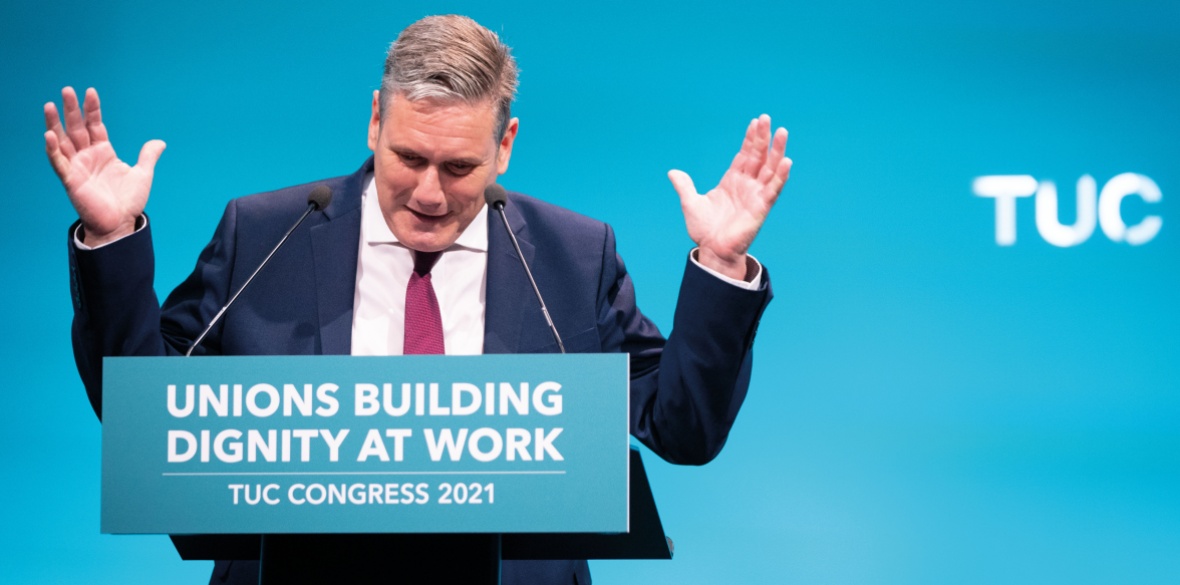This is the last article you can read this month
You can read more article this month
You can read more articles this month
Sorry your limit is up for this month
Reset on:
Please help support the Morning Star by subscribing here
ON CURRENT trends and despite recent turmoil, pollsters are telling us that 2024 seems on course to produce a Labour-led government (at least).
The Tory Party seems likely to be punished for its eugenics and corruption during Covid, the collapse of public services and the economic incompetence of the Liz Truss period.
Issues over how best to continue union-building work in a climate that unions have not had to navigate for 14 years will now come to the fore for many organisations.
We are in an urgent debate over how best unions can avoid the expectation of blank cheque loyalty on every issue that will arise from the party, especially when the shine wears off — and how in the meantime unions resist being policed by Labour. Simply put, will unions choose the role of critical ally or uncritical cheerleader? And what might that look like in 2024 compared to 1997?
A bit of 1997-era history is worthwhile. In 1997 we could have done anything. New Labour was elected with a majority of 179 on a wave of anti-Tory sentiment after 18 years in opposition.
For much of that time, trade unions had adopted the “dented shield” approach, retreating from conflict with employers, and stepping back from industrial campaigning as we waited for a Labour government to arrive and get us off life support.
It cost unions dearly in terms of industrial power and organising energy. With a majority this huge, New Labour decided it no longer had to prioritise engaging meaningfully with unions, and we found ourselves on the back foot and outside the door from the outset, despite pre-election commitments.
At the same time, in fairness, several union leaders sat back and thought their job could now be delegated to the Labour government
Unlike now, when much hope and expectation is invested in Angela Rayner personally, in our corner at the time were several new Cabinet members who had come up the ranks from the shop floor.
Across both wings of the party, they had retained organic relations with workers in their previous industries and their authentic voice, analysis and understanding of what was needed. We also had the draft Employment Bill that had been hammered out over the previous two years and that we now sought to progress in law as we held ministers to their words.
Through this battleground, we struggled, and on the face of it, the unions’ scorecard over the first term was still impressive, with almost everything on our shopping list achieved — at least in name — and several additional policies that channelled significant pots of public money to unions for “modernisation” and lifelong learning.
But the focus was more on creating new employment rights for individuals — much of which could not be enforced — rather than on collective rights to build unions at work. The Labour prime minister at the time later went as far as to celebrate this victory over unions in his autobiography.
As we look closer, however, the picture is less bright. In the detail, which often exists out of sight of the media, the public and union members, there is much to be learned by unions in 2024 from our 1997 experience on how to better campaign and get more for our members from another Labour government — and particularly how to see through the hype and spin.
New Labour set the minimum wage too low to improve lives and it was almost unenforceable by workers. Working Families Tax Credits worked initially but helped usher in the period of state-suppressed wages many workers now struggle with.
Rights to limited union “recognition” through ballots have been barely used due to insufficient effort in the rules to level the imbalances of power and secure union access (as seen in October 2023 at Amazon Coventry).
And the “full employment rights from day one” were all too often not able to be secured due to weak enforcement. Some EU-derived legislation on paid holidays and TUPE, plus the new British right to be accompanied by a union representative, were valuable — but not exploited fully by union builders who often failed to launch collective campaigns around them in workplaces.
The stark truth is union membership decline barely slowed between 1997 and 2010, and the British economy 14 years after Labour lost power remains largely an employment rights-free zone for too many working people — at least a quarter of whom are in precarious work.
The labour market, communities and daily lives of working people in 2024 are all very different to how they were in 1997, and applying 1997 policies to 2024 challenges will do little to improve the lives of working people.
To enable Labour to maintain power in 2029 — when faced with a resurgent Tory Party — unions will need to assist Labour to reconnect with its potential vote from day one in a much more direct and forceful manner than we did in 1997.
The New Deal for Working People published by Labour two years ago has some concrete commitments of value to union builders if enacted and enforced.
And with effective enforcement of employment law still an IOU from Labour to the unions after 120 years, union builders could potentially use these poor legal enforcement processes to drive collective action with the suggested reform of statutory sick pay, rights to access workplaces, fair pay agreements in the care sector and employment rights from day one.
In a direct echo of 1997, the bear trap danger for unions despite these commitments is that we trade off urgent and immediate demands on Labour for longer-term strategic goals in a kind of new pre-emptive “dented shield.”
The imperative in 1997 became to restore trade union rights at GCHQ and the end of the 1993 “re-sign rules” where every union member had to confirm their membership every five years.
Similarly, in 2024 we have the urgent need to remove the minimum service rules, find a way to outlaw fire-and-rehire and allow strike votes to be cast digitally.
All of these are important, but they should not be traded too readily for what unions would really benefit from at the end of a Labour first term: pilots of the four-day week and basic income, the right for every worker to access a union where they work, and the right of union representatives to access every workplace and check on the employer’s compliance with health and safety, the minimum wage and so on — to turbo boost enforcement of the new rights from day one on the job.
There is much for unions to rethink about the union-Labour link in 2024 and much to learn from our successes and failures between 1997 and 2010. But Labour has enormous challenges in its own right that have been emerging for 20 years.
Labour’s disconnect with potential voters began not in recent elections, but decades ago. Organisationally, as well maybe as politically, Labour has taken the votes of some communities for granted for far too long — and paid a terrible price.
Brexit became the petrol thrown onto a fire that was already burning and will be remembered by history as the vehicle the Tories used to take back control of our communities and our lives.
In parallel, 1997-era “differential turnout” campaigning during elections may have finally had its day given the vast changes in the electorate.
It tends to frustrate the deep community engagement which traditionally delivers for Labour by refusing to persuade local voters where they live and work. It aims to suppress the Tory vote and focus on mobilising just known “Labour voters” — often on very flimsy evidence of past voting records.
So many communities and industries are in such a state of flux that the concepts of being either a traditional “Labour voter” or even a town being a “safe Labour seat” feel horribly quaint to many voters.
If Labour in government want to reconnect with communities collectively and voters individually, we need to engage, listen, persuade and organise at a level not yet imagined by Labour leaders — not lecture or dictate to communities.
So in a nutshell, the lessons for union builders from 1997 are both easy to identify and complex to take on board: credibility for a Labour government from 2024 is not to be taken for granted but is there to be constantly earned and re-earned by the party.
Unions can do more to maintain independence from the party in government, put their members’ industrial interests before the Labour Party’s political interests — and keep telling Labour what we really want.
As an organising method in government, the party would be well advised to pick up the union badge from the dust and pin it back on, and to engage for the first time directly with focus groups of union activists, organisers and members to balance out the voices of swing voters in marginal seats, lobbyists, CBI policy wonks, or its placed people in union political units.
They may hear some uncomfortable truths — but an uncomfortable truth from even a distant family member is better than a comfortable lie from the media, or the Westminster bubble.
In the end, union builders don’t rely on governments to do things for them and much has been achieved to build our movement and win since 2010, even under the Tories.
With new rights for union representatives to access workplaces to enforce employment law and the right of workers to have a union representative to visit them where they work, any Labour government can pretty much get out of our way and let us get on with it.









